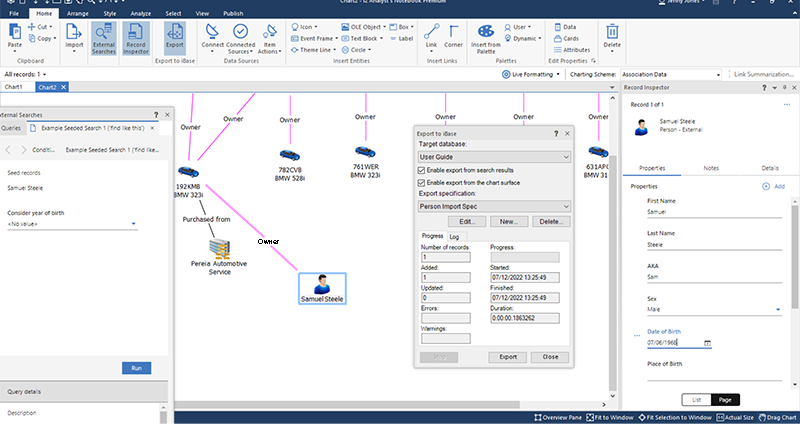Performing analysis with i2 Analyst's Notebook
As an iBase user, the additional functionality offered by i2 Analyst's Notebook connected to i2 Analyze, can enrich your investigations.
This example is to give you an idea of how analysts with different permissions might use the features. The connectors used in this example are for demonstation purposes.
For the purposes of this example, the investigation centers around one main person of interest, known as "Samuel Steele". The analyst needs to demonstrate that Sam was present at the scene of the crime.
Our investigating analyst, who has security permissions on the iBase database, is working in Analyst's Notebook Premium and logged into the i2 Analyze server. They use the Connect option in the Data Sources group, and select their iBase database from the Data Sources pane.
They search for Samuel Steele in iBase with the Find feature and add his iBase record to the chart. They then take Samuel's iBase record as the starting point for an external search. The iBase record is used to seed a search for vehicle owners across the Vehicle Registration Database connector. After running the query, the returned results contain linked records of Person – Owned by – Vehicle.
Our analyst then expands the Vehicle records to reveal links to previous owners, and adds the i2 Analyze records to the chart. The chart contains a selection of records that could be narrowed down to an interesting subset. Our analyst looks at the vehicles that Sam had access to over a certain time range and considers other Analyst's Notebook features, such as Bar Charts & Histograms or Time Wheel to perform some temporal analysis.
They export the i2 Analyze records from the chart to iBase, using the default discriminator settings. The records gain an iBase key. They then notice that a company is linked to Sam's vehicle as a previous owner, and decide to investigate the company with a form-based external search on the Companies House connector. This time, the results contain employee records that have Government IDs but no passport number information. They copy the records to the chart.
As an analyst able to edit the export specification, they are able to specify that Government IDs should be used as a discriminator for the Companies House connector, in place of passport numbers. They keep the usual discriminators of "first name", "last name", and "date of birth". At this point an analyst who is unable to edit specifications could ask a system administrator to create a specification that meets their needs.
The employee records are exported from the chart to iBase, and our analyst observes the matching behavior when matches with iBase records are found.

